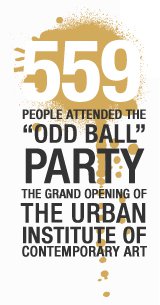Grand Rapids' Heartside neighborhood is now notable for being a growing arts district in downtown Grand Rapids, particularly along Division Ave. between Fulton and Wealthy Streets. But it hasn't always been this way.
The four-blocks now known as the Avenue for the Arts were boarded up buildings and blight in the late 1990s. The homeless population had settled there, due to its proximity to missions and ministries. But in 1998, Reb Roberts and his wife Carmel Loftis signed the lease on the empty building at 140 S. Division, which they would move into in 1999 as
Sanctuary Folk Art, a gallery specializing in pop folk artwork. With a background in child development, working with families for over 20 years, Roberts says his love of the arts came from his work with young children.
Roberts had been putting art in public spaces and blighted neighborhoods long before he came to S. Division, but it was on this block that he began working with Heartside Ministries, a nonprofit that had a small, drop-in program for low-income and homeless persons to make art.

"They had a core group of artists, and it was just going in and painting and meeting the artists (that) I became familiar with persons, (as opposed to) just the neighborhood," Roberts says. "My wife worked at God's Kitchen, so she was familiar with the neighborhood too. I really fell in love with the artists down there. I could see the downside, but because I had a background working with families and kids in depressed neighborhoods, it was a little bit different."
"I was prepared to deal with the neighborhood because I was familiar with it," Roberts says. "I didn't know it was not a good business choice to come down here and be one of the first on the block and having to deal with the terrain as it was. But I wasn't afraid to confront some of those things either."
Roberts got permission to paint on the boarded up storefronts, as he had done in other neighborhoods. "It started to peak an interest," he says.
Initially, Roberts was told that the area around him would start to be developed within the next five months. But five months, he says, turned into five years.
One of the biggest changes happened in 2011 when the UICA relocated to the corner of Fulton and Division as a mixed-used facility.
While a few businesses moved in during those five years, it was in 2004 that the redevelopment Roberts had been waiting for began.
Dwelling Place, a nonprofit established in 1980 to offer affordable housing and support to individual and families, renovated several buildings to become income-based apartments. Several of these spaces also acted as live/work spaces, attracting artists and musicians. Now a residential neighborhood, with many of the residents using storefronts as homes for galleries, yoga studios and salons, the neighborhood was picking up speed. The title Avenue for the Arts was established for the area in 2005.
"What you had for most of those years was those daring individuals -- artists and art admirers -- that really would brave whatever neighborhood to see things they were interested in. And the neighborhood added to the whole flavor," he says. "Then you started bringing ArtPrize people who were naive to the city and because they were en masses, they felt safer. You had young people coming down here who got used to the terrain when they were young, so as they become adults, there's not that fear factor that the established group had with this community."
Recently, the block has seen some relatively new commerce. The Dirty Hippie, a coffeehouse that closed earlier this month, replaced the hole left by Skelletones when it finally closed after a decade in 2009. Grand River Cigar Lounge is now its neighbor, with office suites nearby hosting a number of businesses, including PR/Marketing firm
Clark Communications. In 2008, Rockwell's/Republic, a restaurant and bar, moved in and secured itself with
The Heartside neighborhood was picking up speed by 2005, when the title 'Avenue for the Arts' was established.
consistent clientele. One of the biggest changes happened in late 2011 when the
Urban Institute of Contemporary Arts relocated to the corner of Fulton and Division as a mixed-used facility complete with retail space and apartments.
Still, the neighborhood has its challenges. Jenn Schaub, who acts as Dwelling Place's Neighborhood Revitalization Associate, says, "The most significant changes in recent times have occurred over the last six years, with new development and infill creating more space for retail and storefronts." But as the development along S. Divisions has increased, it has also done so in other neighborhoods, which can create vacancies as businesses relocate for various reasons. As such, the street changes often.
As Roberts anticipates new neighbors filling in remaining vacancies, he attributes his own longevity to the respect one acquires only through that longevity. He deals with the neighborhood as an informed, long-time resident, and by treating everyone he encounters as an individual. With 13 years under his belt, Roberts is truly an urban pioneer.
All photos by Adam Bird
Catalysts for Neighborhood Growth
Downtown MarquetteKurt Mensching shows how small business has transformed Downtown Marquette.
Enjoy this story?
Sign up for free solutions-based reporting in your inbox each week.